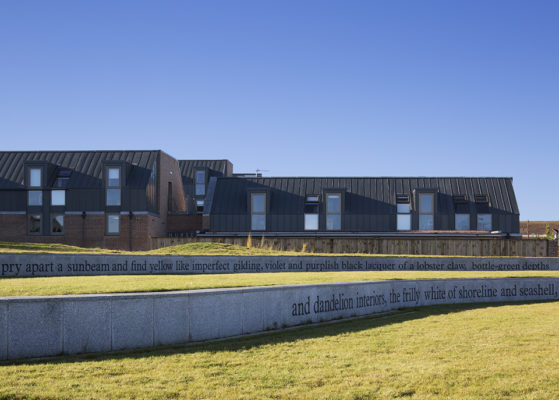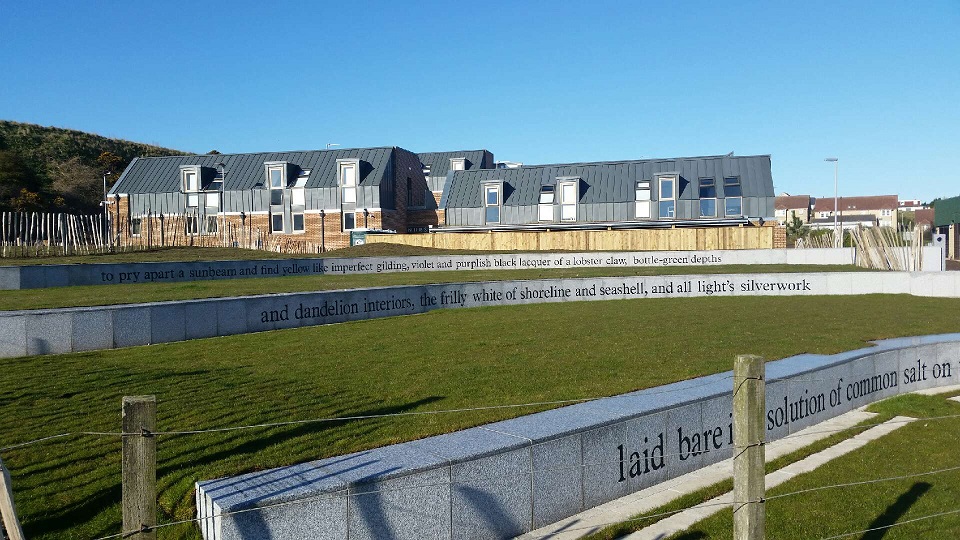Over the next 6 weeks we will be highlighting the poetry which Alumno has commissioned over the years. With each building having a unique character, we believe poetry adds to the sense of place, history and character of each Alumno scheme. We have been lucky to have the assistance of art consultant Matthew Jarratt to source amazing and enthusiastic poets who embrace the brief they are given. Each poet has carefully researched the local area and history of the site, the poem will then be featured in stone or metal as a permanent public work of art. Luckily for guests at the opening of the buildings the poets have been enthusiastic performers of their works. We hope the poems will give you an uplifting read in these trying times….
The first poetry commission was taken up by Jacob Polley in the beautiful coastal setting at East Shore in St Andrews in 2016. His poem “Salted Paper Prints” was inspired by St Andrews` contribution to the birth of photography
This video shows the poem “Salted Paper Prints” in the benches embedded in the landscape between the building and the coast, it also shows the exciting event we held in conjunction with the Stanza Poetry Festival in St Andrews.
Extracts from the poem were engraved in granite as part of the art installation, an outdoor seating area overlooking East Sands and the Fife Coastal Path. Polley’s inspiration for the poem included the pioneers of photography associated with St Andrews such as Sir David Brewster, David Octavius Hill and Robert Adamson. Instrumental in the early development of photography in the 1840s, they led St Andrews to become the world’s first town to be thoroughly documented by photography.
Inspiration for the poem also came from the qualities of light in St Andrews; the town’s old stonework, wynds and entranceways; its academic, bookish and fishing history; the colours and surfaces of the early prints and the calotype process and ingredients used to develop and fix early photographs.
Jacob Polley said: “The poem evokes the processes and subjects of early photographs, specifically in and strongly associated with St Andrews. For example, one of the major problems of early photographs was how to fix the image, which faded in the sun, so the sunlight both created the image and faded it.
“In my opinion, however, poems aren’t to be explained in detail, rather they should evoke and provoke, to be felt and thought about. I hope that featuring this poem in the public art installation will have this effect.”
The full text of the poem can be read and enjoyed below
St Andrews, Salted Paper Prints
*
You loom out of the dark,
hands unstill, a bright-browed
shade from the age of light
and inkwells, a book on your knees
and at your throat a cravat
we can’t take our eyes off,
its tinfoil fish-gleam all
surface, as you are now
you’ve taken to this sheet
of paper, full of bleach-spots,
specklings and shadows deep
as stroked fur, where you’ll
read on as long as we can keep
your face from fading in the sun.
*
Prying apart a sunbeam
you find bottle green,
brick red, sombre blue,
yellow like imperfect
gilding, almost violet
black and purplish black
woody leaf fibres, insect
wings, bare branches
against the low unseeing
winter’s sombre blue
and purplish lacquer of
a lobster claw or summer’s
late sunlight falling through
a wave of bottle green.
*
To have thought yourself
wholly insensible to light
and incapable of change
then to disassemble
and dissolve minerals
of the earth, seaweed
and lavender, that women
baiting a line, their bonnets
frilly-white as seashells,
be taken out of time by
the agency of light,
whose workings, laid bare
in a solution of common salt,
silver the common sand.
*
Depths and interiors
on a surface of sepia, peat-
and tea-stain, soot-rub,
rinse of dandelion- or
saffron-water building stone
or coastal rock in whose hollows
the tide’s arrayed its mirrors
to hold these few hours
an entranceway of sky
no one had noticed opening
into a courtyard or churchyard
or backyard where a man
has filled a bucket and tilts
its cold lens to the light
*
which has taken no time
to reach us from
the kingdom of so
many summer’s ago,
when it acted
to impress the image
of a chapel, open
to the sky, onto this
surface you can touch
and smell as you might
warm stonework or old
book leather or salt
rain blown stinging
into your face.






